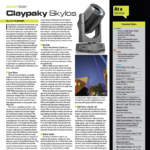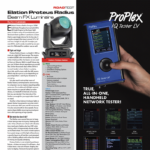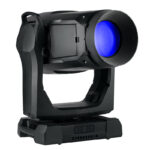I walk into the Morpheus Lights shop in Las Vegas, and the first thing I see are these black balls. Row upon row of little rolling balls emitting light in synchronous harmony. That alone was a pretty big “wow” factor upon first sight. But then I round the corner, and there are bigger balls with multiple light beams emitted in every angle. Rotating continuously in every angle. I am experiencing flashbacks to the 1970’s and the days of disco. I instantly realize that Ayrton, the leading innovator in new LED product manufacturing, has once again come up with some revolutionary products.
On the heels of the MagicPanel-R and MagicBlade-R, Ayrton has added two new members to their Radical series of lighting fixtures. The compact MagicDot boasts a single 60-watt, multi-chip RGBW light source. The larger CosmoPix contains 12 of the same type Osram OSTAR bulbs. They are rated for a life expectancy of 50,000 hours.
 The MagicDot-R
The MagicDot-R
I take a look at the little guy, which weighs in at less than 12 pounds. I simply stand it up on end and attach a PowerCON connector and a 5-pin XLR for DMX. The physical roundness and curves give it a sexy appearance. The fixture is seemingly modular and divided into three parts. A cylindrical shaped base that holds the power supply keeps the fixture standing solidly in place. The middle part of the fixture is the yoke as well as the brains for the unit. On the front base of the yoke is an LCD screen with buttons to quickly set your address and desired mode of operation. The middle section is the same size and round shape. The yoke does not extend outside of the 8.66-inch base diameter. Attached to the yoke is a round head where the LED is located. It indeed looks like a dot. Top to bottom, this fixture is only 13 inches high.
I fire the fixture up in its 16 channel extended mode. Keeping up with the tradition of the Radical series, this fixture has continuous pan and tilt rotation capabilities. I watch as this little light flies through its rotations. I clock the pan speed at 96 rotations per minute, meaning it can turn 360 degrees in well under a second. The tilt speed is even faster — I can rotate the ball two full revolutions in one second. When I run the fixture in regular mode, I notice that I have 540-degree pan access. The light travels smoothly, even at slow speeds. It reacts to efx engine commands instantly and flawlessly.
One of the complaints about moving lights that have continuous rotation capabilities is the time it takes for the fixture to snap out of that mode and return to a pre-assigned focus position. It usually takes between 1.5 and 2 seconds for every fixture I have ever tested to achieve this. The MagicDot-R does this in less than half that time. I tested the CosmoPix-R, and it was able to snap out of a full speed continuous pan and tilt and get to a parked position in about .8 seconds. This is leaps and bounds faster than any other product I have played with.
The light beam is totally collimated. What you see is what you get, a 4.5-degree, soft-edge shaft of light reminiscent of a Star Wars light saber. The new high-efficiency optical system measuring 3.9 inches in diameter required more than two years of development to perfect. While not bright like a discharge light, this beam can still hold its own with 1800 lumens of output. A low amperage level is good as the fixture consumes a mere 130 watts of power. The front lens of the LED cell appears flat with a frosted spot in the center. I imagine this is done to eliminate a hot spot in the beam. When I shine it on a wall from 20 feet away, the field of the circular beam is perfectly flat.
The color system is unique. I easily mix lavender as well as teal hues that are usually missing from most LED fixtures. I notice the individual red, blue, green and white hues are fine by themselves. But when I start mixing colors, I notice the beams looking more multi-colored. Shades of cyan and magenta are pleasantly mixed, but as soon as I try to mix a good amber color, I notice the beam becomes equal part red, yellow and amber. While this may seem like a flaw to some, I doubt I would ever notice in the intended applications I would use this fixture in.
 The CosmoPix-R
The CosmoPix-R
The beauty of these Magic Dot-R fixtures is realized when one utilizes multiple fixtures to create beautiful movement and color peels. Designers will be lining up to mount these fixtures in different arrays. Pixel mapping and running these fixtures through a Madrix or similar LED control system will become a big part of our industry this year. I’m watching lines of them fan out and move in ways that are too beautiful to explain in words. One click to this Ayrton site, and you can see an amazing demo for yourself: www.plsn.me/Ayrton-Demo.
Rather than just limit this new technology to a single fixture, Ayrton has also just shipped the first production models of the CosmoPix-R. This warms my heart deeply, as I have always wanted a professionally made disco ball. I’m not talking about a mirror ball; I mean the spinning balls that used to emit light from Par 36 incandescent bulbs. Ayrton has taken this basic concept and redefined it to a professional and yes —focusable level.
The CosmoPix-R has a head that is close in proximity to the size of a basketball. Yet the relatively small base for it is the same size as one on the MagicPanel fixture. There are a total of 12 individually controlled LED cells surrounding the globe that emit shafts of light in all directions. I am using 66 DMX channels to control the fixture. I set it in a slow tilt rotation alone and turn the balls on full. Great effect. I can bump all the colors on together or chase them independently. Looks like a party. Now I turn off several of the bulbs so that only four of them are on. I purposely choose four bulbs that are in a row. Now, when I rotate the continuous tilt, I have an amazing windmill effect. By adding a sine wave to the pan motor, I now have something really cool as my windmills peel through the room. I turn off the tilt movement and put the pan in rotation. I now have helicopter blades spinning from the truss. I can focus these as well.
 Leaving the disco mode, I simply turn on three bulbs next to each other and I have a 3-beam ACL type fan. I can pan or tilt that fan as fast as I could ever imagine. While in this mode I try out the strobe functions. They work well and there is a random strobe mode available. However, all the LED’s do not strobe randomly between all the cells. At first glance, one might think that this fixture is a one-trick pony with a disco effect. But once the user starts using their imagination they will realize this light has a hundred different cool effects you could accomplish with it. All they have to do is start playing with the built in macros to get a taste of what this fixture can do.
Leaving the disco mode, I simply turn on three bulbs next to each other and I have a 3-beam ACL type fan. I can pan or tilt that fan as fast as I could ever imagine. While in this mode I try out the strobe functions. They work well and there is a random strobe mode available. However, all the LED’s do not strobe randomly between all the cells. At first glance, one might think that this fixture is a one-trick pony with a disco effect. But once the user starts using their imagination they will realize this light has a hundred different cool effects you could accomplish with it. All they have to do is start playing with the built in macros to get a taste of what this fixture can do.
To view the CosmoPix-R in action, go to www.plsn.me/Ayrton-Demo2
At a Glance
More Than a Disco Flashback
At first glance, one might think that Ayrton’s MagicDot-R and CosmoPix-R fixtures are a pair of one-trick ponies with disco effects. But these lights can produce a huge array of interesting effects once you start playing with them.
Ayrton MagicDot-R and CosmoPix-R
PROS: Fast movement and continuous pan and tilt rotation. Great eye candy effects, 60 watt collimated beam. Water-cooled internal system.
CONS: Color mixing orange and yellow hues results in mixed colors.
STATS
Size:
- MagicDot-R: 210 x 318 x 210mm (LxHxD)
- CosmoPix-R:427 x 585 x 352mm (LxHxD)
Weight:
- MagicDot-R: 5.3kg
- CosmoPix-R: 25.1kg
Price (MSRP):
- MagicDot-R: $2,369
- CosmoPix-R: $10,500
More Info:



